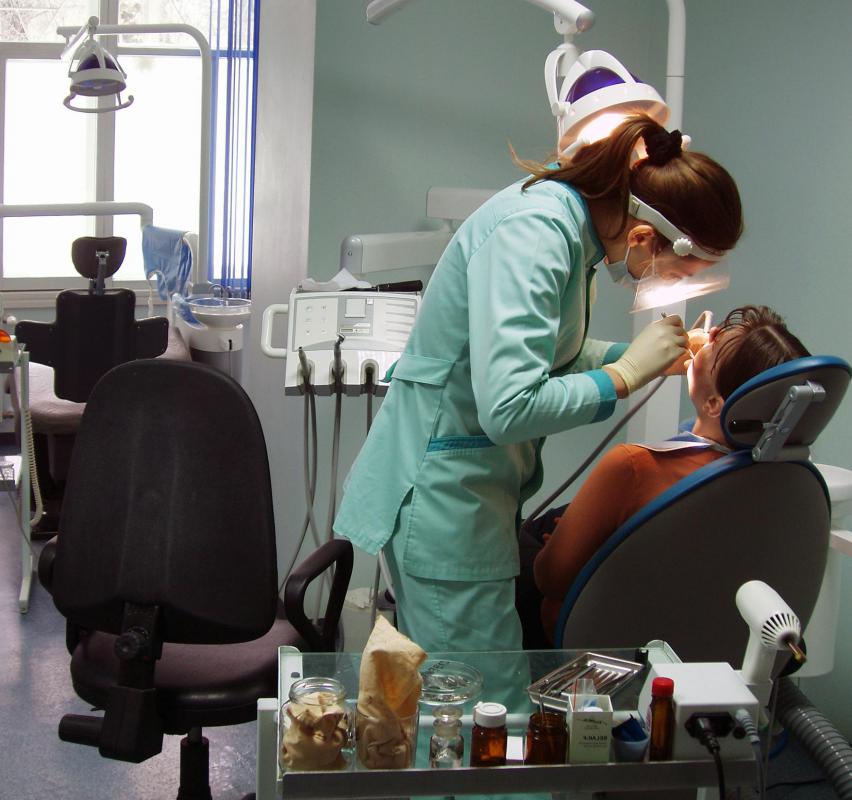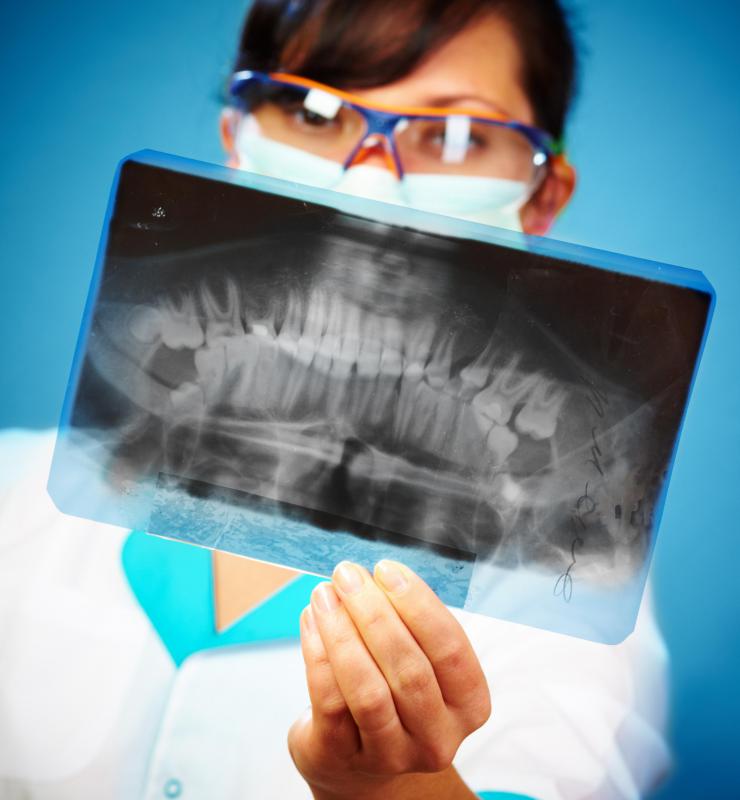At WiseGEEK, we're committed to delivering accurate, trustworthy information. Our expert-authored content is rigorously fact-checked and sourced from credible authorities. Discover how we uphold the highest standards in providing you with reliable knowledge.
What is Crown Lengthening?
When a tooth breaks or has large amounts of decay, it may need to be restored with a filling or a crown. In some instances, there may not be enough of the tooth exposed above the gum line to restore it. Crown lengthening is a surgical procedure performed to remove gum tissue or bone. The procedure exposes more of the tooth and allows for the restoration of the tooth.
To prepare for the procedure, x-rays will be taken. Although it will be removed during the procedure, a temporary crown may be made to cover the broken tooth. Because it is considered a specialized procedure, usually a general dentist will refer a patient to a periodontist who will perform a crown lengthening.

A crown lengthening procedure is done under local anesthesia to numb the mouth. An incision is made in the gum to pull back the gum tissue and allow the dentist to see the nerve and bone. Tissue is removed and possibility bone. Once it has been determined by the dentist enough of the tooth is exposed for restoration the area is flushed with sterile saline and the incision is stitched. Some dentists will cover the tooth with a protective dressing.

The amount of time it takes to perform a crown lengthening varies. Surrounding teeth may need to have tissue removed. Removing bone, along with gum tissue generally makes the procedure take more time. After the numbing medication wears off, the tooth and gum may be uncomfortable, so pain medication will likely be prescribed. A mouth rinse may also be recommended to promote healing. In some instances, antibiotics may be prescribed to prevent an infection.

Although a crown lengthening is considered safe, there are some risks and complications which can occur. Excessive bleeding at the incision site can occur. Some people may have sensitivity to hot or cold foods and drinks. Because some bone may be removed, it’s possible the tooth can become loose.
Another possible complication is an infection. Signs of a serious infection include, fever, excess swelling in the mouth, extreme pain and discharge from the incision site. If these symptoms occur, evaluation by your dentist is needed as soon as possible.
Usually a follow-up appointment will be needed to check the healing process and take out stitches. A permanent crown or filling may not be done until a few months after the surgery. This gives the gum time to heal properly.
AS FEATURED ON:
AS FEATURED ON:














Discussion Comments
I had a molar extracted last Friday, and crown lengthening on the tooth in front of it. The extraction was fairly normal, just the type of pain you'd expect. But the tooth where they did the crown lengthening gave me agony on days three, four and five after surgery. It woke me up in the middle of the night, and I could hardly think about work through the pain. It was like a really bad toothache. It hurt in my lower teeth, my jaw, my nose, up into my cheek.
It's day six now, and the pain has decreased significantly. A stitch came out yesterday, and today my periodontist pulled out the other ones. I'm not sure if somehow the stitches themselves were causing pain -- maybe one was lying right up against the most sensitive point on my tooth?
Anyway, my doctor had told me I'd need Tylenol on the first day, but wouldn't need pain meds the next morning. Therefore, I expected an easy ride. But I ended up needing to be medicated to the hilt (with Advil and Aleve, which are really hard on my stomach) all the time for five days, because as soon as they'd wear off, the pain would get unbearable. I'm still taking an Aleve tonight, for fear of the midnight pain coming back.
So, patients, be aware that this can be a painful healing process. I would have worried less if I had known that this was one possible outcome. Thinking I should be pain-free, I was worried about an infection or maybe a crack in the tooth!
I had two crowns lengthened recently. The worst part of it was getting the novocaine. You don't feel the work because you're numb, so don't get frantic about it! I had mine done seven days ago and things are fine, although I'm dying to eat real food! There's only so much yogurt, soup and tofu one can eat!
@manykitties2 - I underwent cosmetic crown lengthening because I really hated the way my teeth looked. From my experience, I had to wait 3 months after the initial surgery to have my final crowns put into place.
My periodontist told me that it can take quite awhile for the gum area to heal, and that using temporary crowns would suffice until then. I actually didn't mind the waiting period too much as I found the temporary crowns looked fine.
Just let your sister know that once she goes for the real crowns, she'll get a new set of temporary ones first, because it takes a little while to make the final crowns.
My sister recently underwent crown lengthening surgery and it was a really rough week for her. She found herself in quite a lot of pain and the dentist had to prescribe her some morphine to make it over the hardest part. I guess that had quite a lot of work to do on her.
Does anyone know how long after the initial surgery before the final crowns can be put on?
Right now she has temporary crowns in place. I wanted to ask my sister but she hasn't been able to talk much, so I don't want to bother her with pesky questions. I am quite curious to see what her new smile is going to look like.
@Speechie - There are a few options out there, that I know of, probably more. One option, if you are on disability or social security income, is a program called Donated Dental Services. This program locates dentists who give free services to those disabled and are financially ill equipped to pay for services. This can take up to two months just to get someone an appointment, so should be done as soon as possible.
Another option to contact your local and/or state dental associations. Some dentists provide dental service for low-income individuals and/or families.
You can also call the health department and see if there are any health centers that provide dental for free or on a sliding scale. Sometimes the local United Way will know of certain clinics, and in some areas you can call 2-1-1 for information that is not an emergency.
Many friends of mine have gone to a dental school to get reduced rates on dental services.
If you are elderly, you may want to try calling your local Agency for Aging or Office for Aging.
You may be able to find a nice dentist who will work with what you have, or overlook the cost entirely to help you out! Good luck! I hope you get your teeth fixed soon and at a price you can afford!
I have to have two root canals and two crowns put on and my wisdom teeth pulled at some point, and I am not looking forward to this at all! I am glad that I do not have to have crown lengthening, this sounds very painful and possibly pretty dangerous.
The two teeth that I need to have crowned are two of my molars, so at least people can not see that I am missing like a fourth of those two teeth! It looks horrible, but for the most part they do not hurt much at least. I really wish I would have taken care of my teeth better when I was younger, because now I am really paying for the neglect. I used to love going to the dentist when I was younger because I never had to pay for it, and they gave me gifts and toys.
I am no longer a fan of the dentist, although I am grateful they do what they do. My teeth probably would have fallen out by now if it weren't for dentists. I definitely have a sweet tooth, which has been very detrimental to my teeth. I am sure dentist's love seeing me because they get major business from me.
I am going to have to pay thousands of dollars for my crowns, since I have to go to a specialist! Does anyone know of a cheaper route to get crowns and route canals?
@SZapper - I actually had a friend who had this done. She didn't have any trouble during the procedure, but she did get an infection afterwards. That part was pretty awful.
In her case, she was supposed to be taking antibiotics and just didn't take them. Yep, she's one of those people that will take half the bottle and then stop because she "feels better."
Anyway, her whole mouth swelled up and she was running a pretty serious fever. She ended up having to go on some strong antibiotics (she took the full course of those at least.) Luckily she didn't have to be hospitalized, but it was a close call!
Oh wow. I've had to have a few crowns done, but I've never needed crown lengthening. I have a serious phobia of the dentist too, so this sounds just awful to me.
I think I would definitely need to under general anesthesia to have this done. The whole idea of a dentist making an incision into my gums down to the bone sounds extremely scary.
Post your comments